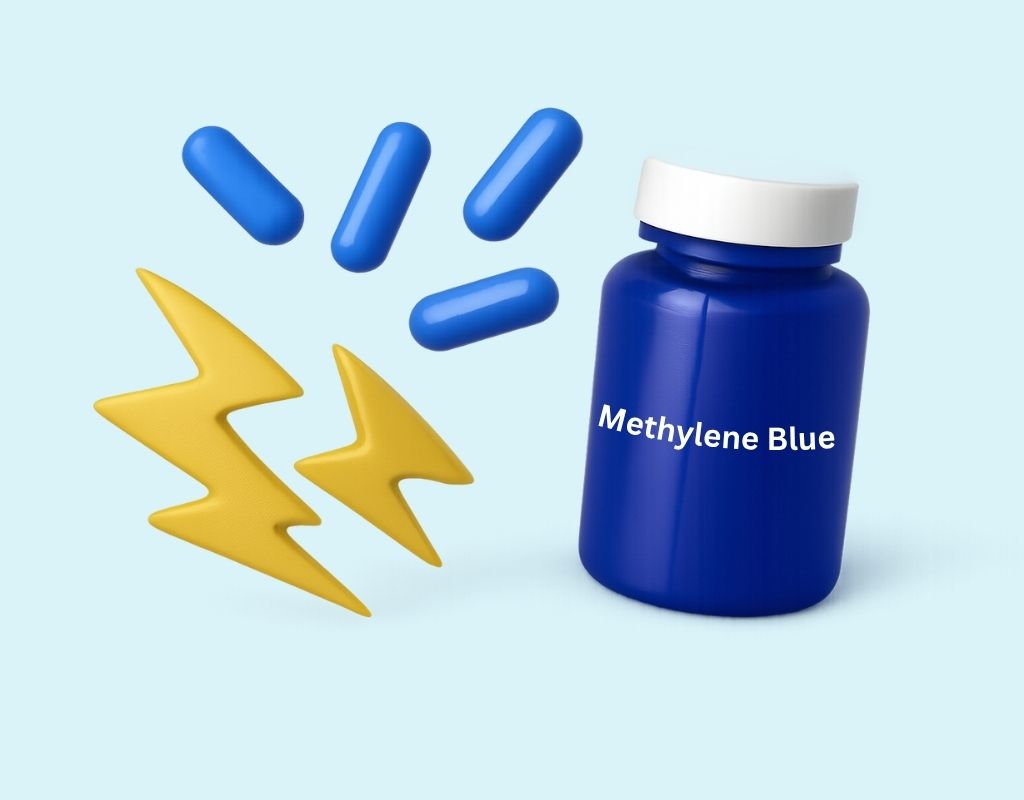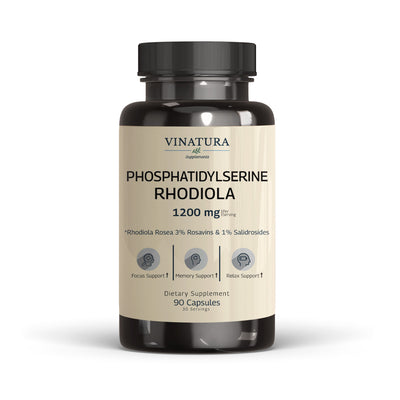
Can Methylene Blue Supplements Boost Your Energy?
Fatigue and low energy are common issues for many people today. As a result, there is growing interest in supplements that enhance health and alertness. Recently, Methylene Blue has gained attention as a new option among energy- and brain-supporting supplements. But can it support cellular energy and function?
Before exploring further, please read the disclaimer located at the end of this webpage.
Key Takeaways
- Methylene Blue (MB) is being studied as a nootropic and dietary supplement.
- MB may support mitochondrial function and enhance cellular metabolism when taken in low doses.
- Microdosed forms are preferred over medical-grade applications.
- Low-dose MB is being studied for its potential to support cellular energy, though these effects in humans remain unproven.
Is Methylene Blue Used As Supplements?
Methylene Blue (MB) is a compound that has long been utilized in the medical field [1]. Recently, an increasing number of studies have explored its potential at low doses as a dietary supplement, a nootropic for cognitive support, and a compound that may enhance mitochondrial function.
MB is available in several forms. In medicine, it comes in intravenous solutions (1% MB), injectable formulations, and oral tablets. In the supplement market, it is often sold as a liquid solution (for drops or mixing) or in low-dose capsules and tablets. Common forms include:
- Methylene Blue Solution (usually with a concentration of 0.5–1%, used for drops or dilution)
- Oral tablets or capsules (containing low doses of Methylene Blue for ingestion, typically 0.5–4 mg per kg of body weight)
In summary, supplement-form MB is generally microdosed, with just a few milligrams per serving, unlike the higher doses used in medical settings under prescription. It’s important to understand that MB remains a potent active compound and should only be used under professional guidance.
How Methylene Blue Might Support Energy Production
To better understand how Methylene Blue supports energy production, let's first review a few key points.
Supporting Mitochondrial Function
According to findings by Gonzalez-Lima & Auchter (2015), mitochondria, often referred to as the "powerhouses" of the cell, are especially crucial for neurons since the brain requires a high amount of energy to function properly.
Their research shows that at low doses, methylene blue (MB) can selectively enter neuronal mitochondria and serve as an electron carrier in the mitochondrial electron transport chain.
In simpler terms, low-dose MB helps the energy production machinery inside mitochondria run more smoothly, much like adding lubricant to keep a machine operating efficiently.
Based on this mechanism, MB may:
- Enhance mitochondrial respiration
- Support energy metabolism
- Support neuronal survival and function
By improving mitochondrial efficiency, MB could help protect neurons from damage and reduce stress.

Enhancing Cellular Respiration
Every cell in our body needs energy to function, and most of that energy is produced inside the mitochondria. When the mitochondria operate efficiently, the body has enough energy to maintain memory, focus, and overall health.
Under normal conditions, mitochondria use a complex chain to transport electrons and generate energy (known as the electron transport chain – ETC). However, when part of this chain is damaged (such as complex I or III), the energy production process is disrupted.
Methylene Blue (MB) can bypass the damaged part by directly transferring electrons to the end point of the chain (cytochrome c), allowing the energy production process to continue [11,13,14].
In addition, when MB "bridges" the electron transfer process, mitochondria respire better, use oxygen more efficiently, and increase ATP production – the form of energy that cells use [14].
By maintaining a stable electron flow and protecting the "mitochondrial membrane potential," MB helps reduce the production of harmful free radicals, thereby protecting cells from aging and damage. Finally, MB is particularly beneficial for brain cells and glial cells (astrocytes).
These cells consume a lot of energy and are highly vulnerable to oxygen deficiency or metabolic stress. MB helps sustain the vital function of these cells in harsh environments [11,13,14].
(*) Astrocytes are multifunctional cells in the brain that support neurons, maintain the blood-brain barrier, and regulate energy metabolism.
However, it is important to note that most current studies on Methylene Blue (MB) are still in the early stages, primarily conducted on animals or in vitro. Therefore, the effects of MB on humans have not yet been clearly proven.
What Does the Research Say?
So far, most research on methylene blue (MB) and cellular energy remains in early stages—mainly in vitro (test tube) or animal studies. Below are a few summarized examples:
|
Study |
Subjects |
Dosage |
Effect on Energy |
Notes |
|
Methylene blue stimulates substrate-level phosphorylation catalysed by succinyl-CoA ligase in the citric acid cycle (Komlódi & Tretter, 2017) [7] |
Mouse brain mitochondria (in vitro) |
Not applicable (various concentrations tested in vitro) |
Stimulates ATP production via the succinyl-CoA pathway, helping maintain ATP levels when energy is limited. |
Biochemical in vitro study. |
|
Targeting mitochondria with methylene blue protects mice against acetaminophen-induced liver injury (Lee et al., 2015) [8] |
Male C57BL/6J mice and mouse liver cells (in vivo + in vitro) |
10 mg/kg (intraperitoneal), administered 90 min after 450 mg/kg APAP |
MB restores ATP production by shuttling electrons from damaged Complex II to cytochrome c, preventing ATP loss and liver cell necrosis. |
MB bypasses Complex II blocked by NAPQI, reduces acetaminophen-induced liver damage, without interfering with APAP metabolism. |
|
Effect of methylene blue on cardiac output response to exercise in dogs (J Appl Physiol, 1986) [9] |
Dogs (3 groups: saline, MB + exercise, MB without exercise) |
Initial 4 mg/kg bolus, followed by continuous infusion at 0.15 mg/kg/min during exercise |
Reduced lactate/pyruvate ratio → improved tissue oxidation, less anaerobic metabolism during exercise. No negative impact on cardiac output or oxygen consumption. |
Indicates MB helps balance energy during physical activity without affecting hemodynamics. |
These findings illustrate only preliminary data. Several studies suggest that MB may enhance ATP production indirectly by improving mitochondrial electron transport and substrate-level phosphorylation [7].
However, most evidence comes from lab and animal studies—there is a lack of well-conducted clinical trials in humans to confirm its energy-boosting effects.
Therefore, while promising, these benefits in humans remain unproven. Many scientists caution that labeling MB as an “energy elixir” is still hypothetical at this stage [10].
While MB may have potential benefits for cellular energy, it should not be considered a definitive solution for boosting energy levels. More human clinical trials are needed to validate its effects.

Real User Experiences: Do People Feel More Energized?
On various online platforms such as Reddit, many users have shared their personal experiences with low-dose Methylene Blue (MB). While some individuals report improved mental clarity, further studies are needed to confirm MB’s effectiveness for cognitive support.*
On Reddit, some individuals recovering from long-term fatigue conditions, also reported that MB played a supportive role in restoring stamina and stabilizing energy levels throughout their healing process.*
They described MB as a helpful aid that helped them stay alert and recover more quickly—especially when combined with proper nutrition and a healthy lifestyle.*
Notably, on the LongeCity forum, many users claimed that even microdoses (e.g., 50–60 micrograms per use) produced noticeable effects.*
Some said they felt less fatigued and remained alert throughout the day, even with limited sleep. These accounts suggest that MB may have potential in supporting cellular energy and cognitive function, but individual experiences may vary, even at very low doses.*
However, some users do not experience such noticeable benefits. Opinions on the effectiveness of MB vary, with some individuals not noticing clear effects or expressing caution about its safety, synthetic origin, and potential side effects.*
As a result, the user community continues to explore the long-term effectiveness of MB in enhancing energy levels.*
Proper Usage and Dosage for Energy Support
The effectiveness of methylene blue (MB) largely depends on the dosage due to the phenomenon of hormesis, where low and high doses can produce opposite effects.
- Low doses (0.5–4 mg/kg): May support mitochondrial respiration, cognitive function, and cellular energy; shown to be safe and effective in both animals and humans [11].
- Moderate doses: May show minimal or unclear effects [11].
- High doses: May be toxic, increasing methemoglobin levels (leading to hypoxia), inhibiting cellular function, and potentially causing harm despite benefits observed in vitro [11].
Some guidelines suggest a maximum safe dose of around 2 mg/kg (approximately 140 mg for a 70 kg person). However, this falls within therapeutic drug levels, not typical supplement use [12].
Doses exceeding 5–7 mg/kg may increase the risk of side effects, including serotonin syndrome, especially when combined with serotonin-enhancing medications like SSRIs.
Conclusion: It’s essential to consider dosage when discussing MB, as different doses can lead to vastly different, even opposite, outcomes.

A Few Tips for Use:
- First-time users: Beginners should start with a very low dose (e.g., 0.5–1 mg, equivalent to a few drops of a 1% MB solution) to observe how the body reacts. If no side effects occur, the dose can be gradually increased.
- Timing: MB is typically taken in the morning or before physical activity, as it can increase alertness. Taking it close to bedtime may lead to difficulty sleeping or nighttime wakefulness.
- Safety note: Avoid using high doses of MB continuously every day. It’s recommended to cycle use (e.g., several days on, then days off or weekly cycles) to prevent accumulation.
Precautions, Side Effects, and Who Should Avoid It
Although low-dose MB is generally considered safe, it’s not suitable for everyone. Some mild side effects have been reported:
- Blue urine or skin tint: A common and harmless effect due to MB’s blue color [12]. This effect is generally harmless but may cause concern if users are not aware beforehand.
- Digestive issues: Nausea, vomiting, stomach discomfort, or diarrhea can occur. Drinking plenty of water or taking it with food may reduce these effects.
- Headache or dizziness: Some users experience mild headaches or lightheadedness after the first dose. These symptoms usually fade over time, especially if starting with low doses.
- Other rare symptoms: Fatigue, hand tremors, dry mouth, or pale skin, typically associated with overdosing.
Groups That Should Be Cautious or Avoid MB:
- People with G6PD deficiency: MB may cause hemolysis (red blood cell breakdown) in those with G6PD enzyme deficiency and should be completely avoided [12].
- Pregnant or breastfeeding women: MB can cause birth defects at high doses (Category X drug). Always consult a doctor before use.
- People on antidepressants (SSRI/SNRI/MAOI): MB may increase the risk of serotonin syndrome when combined with serotonin-enhancing medications [12]. Anyone taking psychiatric medications should consult their physician before trying MB.
- People with cardiovascular conditions or high blood pressure: MB may affect blood pressure. Caution is advised for those with heart disease or hypertension.
In summary, while low-dose MB shows promise in supporting cellular energy, its use must be approached with caution. It is not a general supplement for the masses. Users should prioritize improving energy through diet, sleep, and lifestyle, and consider MB only with proper medical guidance.
Conclusion
Methylene Blue (MB) is a compound with great potential, increasingly gaining attention from the scientific community for its ability to support mitochondrial function and promote cellular health.
While low-dose MB shows potential in supporting mitochondrial function and cognitive health, its effectiveness and safety in humans still require further study. It is important to use MB under the guidance of a healthcare professional.
Testimonial Disclaimer
*The testimonials presented on this website are provided by individuals based on their personal experiences with our products. These testimonials represent individual opinions and experiences, which may not be typical or applicable to all users of our products. Results may vary depending on a variety of factors, including individual health, lifestyle, and adherence to product usage instructions.References
- [1] Poteet E, Winters A, Yan LJ, et al. Neuroprotective Actions of Methylene Blue and Its Derivatives. PLoS ONE. 2012;7(10):e48279-e48279. doi:https://doi.org/10.1371/journal.pone.0048279
- [2] Xue H, Abhirami Thaivalappil, Cao K. The Potentials of Methylene Blue as an Anti-Aging Drug. Cells. 2021;10(12):3379-3379. doi:https://doi.org/10.3390/cells10123379
- [3] Sváb G, Kokas M, Sipos I, Ambrus A, Tretter L. Methylene Blue Bridges the Inhibition and Produces Unusual Respiratory Changes in Complex III-Inhibited Mitochondria. Studies on Rats, Mice and Guinea Pigs. Antioxidants. 2021;10(2):305. doi:https://doi.org/10.3390/antiox10020305
- [4] Sváb G, Kokas M, Sipos I, Ambrus A, Tretter L. Methylene Blue Bridges the Inhibition and Produces Unusual Respiratory Changes in Complex III-Inhibited Mitochondria. Studies on Rats, Mice and Guinea Pigs. Antioxidants. 2021;10(2):305. doi:https://doi.org/10.3390/antiox10020305
- [5] Cuffari B. News-Medical. News-Medical. Published July 2019. Accessed June 25, 2025. https://www.news-medical.net/health/Potential-Health-Benefits-of-Methylene-Blue.aspx
- [6] Atamna H, Nguyen A, Schultz C, et al. Methylene blue delays cellular senescence and enhances key mitochondrial biochemical pathways. The FASEB Journal. 2007;22(3):703-712. doi:https://doi.org/10.1096/fj.07-9610com
- [7] T. Komlódi, Tretter L. Methylene blue stimulates substrate-level phosphorylation catalysed by succinyl–CoA ligase in the citric acid cycle. Neuropharmacology. 2017;123:287-298. doi:https://doi.org/10.1016/j.neuropharm.2017.05.009
- [8] Lee KK, Imaizumi N, Chamberland SR, Alder NN, Boelsterli UA. Targeting mitochondria with methylene blue protects mice against acetaminophen‐induced liver injury. Hepatology. 2014;61(1):326-336. doi:https://doi.org/10.1002/hep.27385
- [9] Imai N, Paley JI, Barold HS, Liang CS. Effect of methylene blue on cardiac output response to exercise in dogs. Journal of Applied Physiology. 1986;61(6):2012-2017. doi:https://doi.org/10.1152/jappl.1986.61.6.2012
- [10] Is methylene blue really a brain booster? University of South Carolina. Published 2025. Accessed June 25, 2025. https://sc.edu/uofsc/posts/2025/06/06-convo-hofseth-meth-blue.php
- [11] Gonzalez-Lima F, Auchter A. Protection against neurodegeneration with low-dose methylene blue and near-infrared light. Frontiers in Cellular Neuroscience. 2015;9. doi:https://doi.org/10.3389/fncel.2015.00179
- [12] Evangelos Bistas, Sanghavi DK. Methylene Blue. Nih.gov. Published June 26, 2023. Accessed June 25, 2025. https://www.ncbi.nlm.nih.gov/books/NBK557593/
- [13] Sváb, G., Kokas, M., Sipos, I., Ambrus, A., & Tretter, L. (2021). Methylene Blue Bridges the Inhibition and Produces Unusual Respiratory Changes in Complex III-Inhibited Mitochondria. Studies on Rats, Mice and Guinea Pigs. Antioxidants, 10(2), 305. https://doi.org/10.3390/antiox10020305
- [14] Roy Choudhury, G., Winters, A., Rich, R. M., Ryou, M.-G., Gryczynski, Z., Yuan, F., Yang, S.-H., & Liu, R. (2015). Methylene Blue Protects Astrocytes against Glucose Oxygen Deprivation by Improving Cellular Respiration. PLOS ONE, 10(4), e0123096. https://doi.org/10.1371/journal.pone.0123096
Author

Product Disclaimer
Including an ingredient or study does not evaluate, endorse, or recommend any Vinatura product or any third-party product. Some ingredients discussed may not be used in any Vinatura product.
The content of the articles has not been evaluated by the Food and Drug Administration (FDA) and is not intended to promote or endorse any specific product. Any products sold on this website are not intended to diagnose, treat, cure, or prevent any disease.
Opinions and Endorsements
Any claims, statements, or opinions expressed in the articles are those of the author(s) and do not necessarily reflect the views or opinions of the manufacturers of the dietary supplement products. The products sold on this website are separate from the content of the articles and are not directly endorsed or associated with the information presented here.
Liability Disclaimer
The author(s) of the articles, website, and manufacturers of the dietary supplement products do not assume any liability for any potential consequences arising from the use of the information provided in the articles. Ingredient effects, dosages, and safety vary by individual, formulation, and context; some ingredients interact with medications or may be unsuitable during pregnancy or lactation. It is recommended that individuals consult with a qualified healthcare professional before making any dietary or lifestyle changes, including the use of dietary supplements.
Product Usage
Please refer to the product labels and packaging for specific usage instructions and guidelines for the dietary supplement products sold on this website.
Customer Support
For any concerns or questions regarding the dietary supplement products, please contact our customer support team, who will be more than happy to assist you.





Leave a Comment
Be the first to comment.
What do you think?